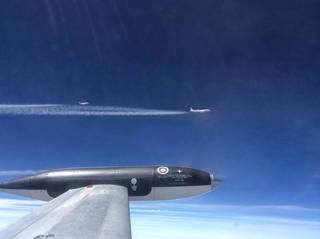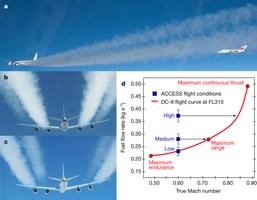A new study from the US space agency, NASA, found that compared to conventional fuels, biofuel in jet engines can reduce harmful particle numbers and mass emissions in their exhaust trails by as much as 50 to 70 percent.
The study, released on Thursday, showed that aviation-related aerosol emissions contribute to the formation of contrail cirrus clouds that can alter upper tropospheric radiation and water budgets. These effects mean emissions released at these altitudes carry a much higher cost on the environment than those released on the ground.
Worldwide, flights produced 781 million tons of CO2 in 2015, according to the Air Transport Action Group (ATAG). Civil aircraft-in-flight contributed around two percent of the world's CO2 emissions in 1999.
The cooperative international research group published their findings in the journal Nature, and was led by NASA and involved agencies from Germany and Canada.
Data was gathered during flight tests in 2013 and 2014 near NASA's Armstrong Flight Research Center in Edwards, California, and looked at the impact of alternative fuels on the performance of engines, emissions, and aircraft-generated contrails seen at altitudes that commercial airliners reach.

NASA's HU-25C Guardian aircraft flies 250 meters behind the agency's DC-8 aircraft on May 14, 2014, before it descends into the DC-8's exhaust plumes to sample ice particles and engine emissions. / NASA Photo
The test series were part of the Alternative Fuel Effects on Contrails and Cruise Emissions Study (ACCESS).
NASA described the contrails as being produced by hot aircraft engine exhaust mixing with the cold air that is typical at cruise altitudes several miles above Earth's surface, and are composed primarily of water in the form of ice crystals.
"Soot emissions also are a major driver of contrail properties and their formation," Bruce Anderson, ACCESS project scientist at NASA's Langley Research Center in Hampton, Virginia, said in a statement.
"As a result, the observed particle reductions we've measured during ACCESS should directly translate into reduced ice crystal concentrations in contrails, which in turn, should help minimize their impact on the Earth’s environment."

Side and forward views of DC-8 contrails and the operational cruise curve. / Nature Photo
The benefits come not just from reducing carbon emitted directly into the atmosphere, but by also cutting down the chance of contrails forming, which can have an even bigger impact on the Earth's atmosphere.
The results from research aircraft that sampled the exhaust of engines onboard a NASA DC-8 aircraft as they burned conventional Jet A fuel and a 50:50 (by volume) blend of Jet A fuel and a biofuel derived from Camelina oil.
"This was the first time we have quantified the amount of soot particles emitted by jet engines while burning a 50-50 blend of biofuel in flight," said Rich Moore, lead author of the Nature report.
Researchers plan on continuing these studies to understand and demonstrate the potential benefits of replacing current fuels in aircraft with biofuels. It's NASA's goal to demonstrate biofuels on their proposed supersonic X-plane, according to the agency.
(Source: Xinhua)









